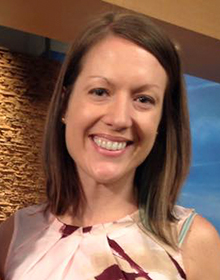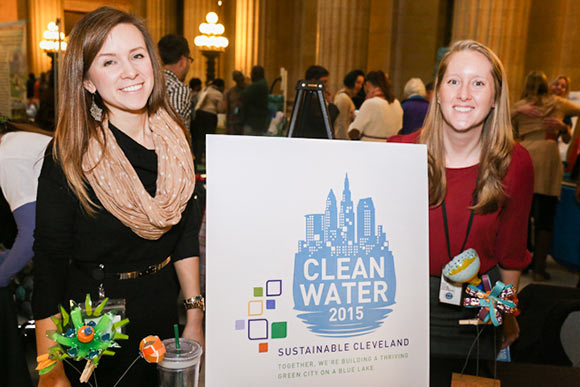Social entrepreneurs making waves in Northeast Ohio
This week, Sustainable Cleveland 2019 (SC2019) celebrated the Year of Water. This was the seventh of ten planned meetings that will end in 2019, the 50th anniversary of the Cuyahoga River fire.
The annual conferences have launched numerous work groups and programs to address such sustainability areas as alternative energy, local food, reforestation, transportation, vacant land and zero waste.
Local water has stood as a primary focus from the start, because you can’t build a thriving Green City on a Blue Lake – the mission and ultimate goal of all SC2019 efforts – without the Blue Lake.
Here are four organizations are leading the way in social innovations toward achieving the goals of SC2019 and truly embracing the Year of Water.
 Erin Huber
Erin Huber
An International Effort
Erin Huber celebrates water every day. “I have always connected to water throughout my life,” says the native Clevelander who grew up just streets away from Lake Erie. “So I got really angry when I saw that people didn’t care about it.”
Spurred by her frustration at the complacency she saw in Northeast Ohioans who take fresh water for granted, Huber founded her nonprofit organization Drink Local, Drink Tap (DLDT) at the first SC2019 summit in 2009.
Huber had just enrolled in graduate school at Cleveland State University, pursuing her MS in sustainability policy and new economics, when a professor told her about Mayor Frank Jackson’s new initiative intended to make Cleveland more sustainable in multiple areas by 2019.
After the summit a group of like-minded volunteers, under Huber’s leadership, implemented various activities, including passing out flyers, giving talks about tap water versus bottled water, teaching programs in the Cleveland schools and caring for Edgewater Beach.
“Before the Metroparks took over, they had no money, no oversight and needed a lot more help, so we started doing beach clean-ups all year long,” Huber recalls of the group’s efforts to clean up the beach.
DLDT has grown significantly since then, becoming a 501 (c) 3 nonprofit organization in 2013. This past May, Huber moved DLDT out of her home into an office on West 29th Street above Rising Star Coffee Roasters in Ohio City.
Along the way, Huber met a teacher from Uganda at the now-closed Stokes Central School. The meeting prompted Huber to travel to Uganda to explore the water crisis in African countries and film a documentary, Making Waves from Cleveland to Uganda.
DLDT now has a Uganda office and Huber’s trying to strengthen the foundation there as she simultaneously works on securing the foundation for DLDT here.
Huber is still frustrated by the majority of people who take access to water for granted. But she is confident in the collective ability to discuss and solve water challenges -- even addressing the impending conflicts that may rise in areas where water is not as accessible.
That is the subject of Huber’s third documentary, focused on the Kilimanjaro region in Tanzania, where she and her cinematographer recently spent time filming the water stress due to water supply and climate changes. She’s hoping to complete the documentary by the end of this year.
“Being near the Great Lakes we’re not feeling it, but it’s important for people to know that it’s happening,” Huber says. “We have to try to fix things that we may have broken accidentally along the way. So we hope that telling these stories, whether they take place in Cleveland or Africa, will inspire people to think about what they’re doing in their daily lives with water.”
To learn more about DLDT, attend the Second Annual Giving Splash Party on Saturday, September 26 from 6 to 10 pm at the Rising Star on 3619 Walton Avenue, Cleveland; or participate in the Adopt-A-Beach team cleanups at Perkins Beach in Edgewater Park on October 24.
Let it Rain
Since Mitchell’s Ice Cream installed its rainwater harvesting system in its Ohio City store in December 2014, co-founder Mike Mitchell has never viewed a huge downpour the same way again.
“It might be a little lousy out during a thunderstorm, but I look at it in the sense that we’re making toilet water,” Mitchell says. Indeed, his enthusiasm for mitigating our region’s Combined Sewer Overflow (CSO) problem is infectious.
 Rainwater collection tank in the basement at Mitchell's
Rainwater collection tank in the basement at Mitchell's
“It’s obviously one of our most imperative environmental priorities here in Northeast Ohio,” Mitchell continues. “We have this giant lake, so while water conservation is important, we have a sewer problem with CSO contaminating the lake. So we were motivated by sewer water conservation to keep our water out of the lake.”
How does rain and snowmelt recycling create toilet water? Well, Mitchell’s system collects rainwater off of the roughly 8,000 square-foot roof and channels it into a 10,000-gallon underground cistern.
Mitchell’s then pumps that water back into the building for everything from flushing toilets and tempering drain wastewater from its dishwasher to watering plants in Gould Court -- the urban park area Mitchell’s created by getting permission from the city to redevelop the brick alleyway next to the building.
Mitchell’s then received a grant from the Northeast Ohio Regional Sewer District to install the rainwater recycling equipment as a demonstration project. It is the first one in the city. For the past ten months since the system went online, none of the building’s rainwater or snowmelt has gone into the Cleveland sewer system and Lake Erie.
While rainwater recycling systems have been implemented in Israel, Europe and on the West Coast, Mitchell hopes that his stands as a model of “the effectiveness, fun and the good feeling” from knowing you’re reducing the CSO problem, so that businesses and home owners will consider installing similar systems.
“We live on a lake where every time it rains, we’re ruining it with runoff, and that shouldn’t be allowed to happen,” Mitchell concludes. “So, it’s incumbent on each of us to solve that problem.”
 AMR technologyDrip, Drip, Drip
AMR technologyDrip, Drip, Drip
Water leaking from your pipes or fixtures adds to monthly water bills.
In 2012, the Cleveland Division of Water took a major step in conserving your water and hard-earned cash by initiating the Automated Meter Readings Project. The initiative required the replacement of old manually-read meters with new ones that could be read automatically.
The AMR technology enables Cleveland Water to collect hourly information on water usage for each property in the system. The assumption is that at some point during the day, water consumption should be zero, say at 3a.m. when you’re sleeping or noon when you’re at work. If a residence goes without zero usage occurring over a seven-day period, the division will notify property owners so they can have the leaks fixed.
Currently, 92 percent, or 385,000 out of 420,000 meters in Northeast Ohio, have been upgraded to the new AMR system.
Jason Wood, chief of public affairs of the Cleveland Department of Public Utilities says, “Once we confirmed that all of the IT interfaces that transmit the data from the meters into our network and then into our billing system were working correctly, we ramped up installations.”
Since firing up the AMR system, Cleveland Water has issued 16,778 possible leak notices, Wood says, and of that total 86 percent, or 14,438 residences, have dropped off the AMR leak report.
“The biggest impact of the AMR system is on customers, because it helps them control their utility bill costs,” Wood explains, adding that in the past the only way a customer would know they may have a significant leak problem was to get an unusually sizable bill one month.
Being a municipal water division, however, does not make their equipment immune to leaks. Wood says Cleveland Water is currently planning a comprehensive water audit of its entire distribution system to identify leaks on their side of the flow.
“That way, we can try to resolve some of these leaks before they turn into water main breaks and surface and become real headaches for people,” he says.
 Water First for Thirst
Water First for Thirst
University Hospitals Case Medical Center wants its employees to step away from the bottled water. UH, a sponsor of SC2019 for the past three years, began implementing the Water First for Thirst campaign for 2015 as a member of Healthy Cleveland’s Healthy Eating Committee.
“We’ve been committed to water efficiency, sourcing clean water and providing water as a first option for people choosing beverages since the beginning of this year, in alignment with the SC2019 Year of Clean Water,” says Matthew Pietro, sustainability specialist at UH.
Previously, Pietro explains, when someone scheduled a catered meeting or event at UH, the default was to provide bottled water. Now, tap water in pitchers replaces the plastic bottles whenever possible. People can also request water infused with mint or fruit to provide a light flavoring.
“We’ve tried to put the focus on a health and wellness perspective as well as on the environmental and cost savings benefits,” says Pietro, who has attended the SC2019 event since the first summit in 2009. Additionally, UH is working on replacing bottled water with pitcher stations with herb- and fruit-infused water in its retail operations.
According to UH Office of Sustainability statistics, between January 1 and June 1, 2015, UHCMC served 2,445 guests who ordered pitchers of water compared to 804 guests during that same time period last year. In August 2015, the hospital reduced bottled water purchases by 60 percent, and water pitcher orders were up 262 percent, compared to August 2014.
This October, in celebration of Food Day (Oct. 24), Healthy Cleveland is holding a Why I Drink Water art contest that includes two Cleveland Public Schools: Luis Munoz Marin School on the west side and Case Elementary School on the east side. UH is involved as part of its Water First for Thirst efforts. Winners from various grade levels will have their water or healthy eating related drawings displayed in one of UH’s hallways and will be invited to a special reception.
UH employees can participate in the Eat Real Food photo contest by submitting images of how they are incorporating local and sustainably produced foods into their daily lives.
“Every message we try to send from our sustainability program is associated with health and wellness, which is core to the UH mission,” Pietro concludes. “So there’s a good synergy with our choice to encourage our employees and our patients to make water their beverage of choice.”
These four different approaches to protecting and preserving clean water in our water-rich Great Lakes region all contribute to Cleveland’s decade-long initiative to become more sustainable and green in its practices by 2019 and beyond.

About the Author: Christopher Johnston
Christopher Johnston has published more than 3,000 articles in publications such as American Theatre, Christian Science Monitor, Credit.com, History Magazine, The Plain Dealer, Progressive Architecture, Scientific American and Time.com. He was a stringer for The New York Times for eight years. He served as a contributing editor for Inside Business for more than six years, and he was a contributing editor for Cleveland Enterprise for more than ten years. He teaches playwriting and creative nonfiction workshops at







.jpg)




